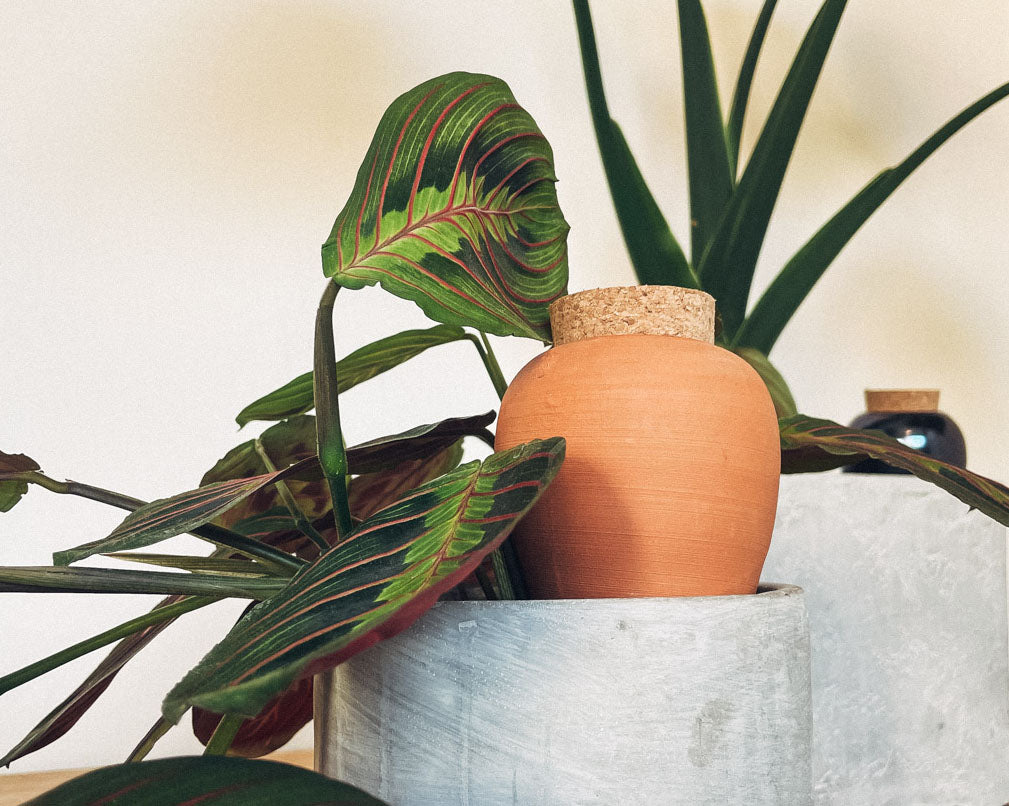Natural, aesthetic and designed with recyclable materials, they make it possible to water the plants very gently, to save water and above all to be able to go on vacation without the hassle! As much loved by those who do not have a green thumb, as by fans of capricious plants, let's discover the advantages of this ecological and intelligent watering technique, which has become a must for contemporary and committed gardeners.
How to choose your oyas?
On the market, you will find two types of oyas: those to be buried and those to be planted. What differences are there? And what are they suitable for?
Oyas to plant
They are generally of a lower capacity (from 15 to 25 cl) and are enamelled on the upper part. Rather intended for indoor plants, their designs are made not to take up too much space in the pots. They are therefore to be planted so that the water reserve is outside the pot.
They are very often enamelled to make the part in contact with the air impermeable, but also to bring a decorative side to your plants and participate in the atmosphere that you wish to give to your interiors.
For whom: Plantable oyas are ideal for indoor plants. They are particularly used by city dwellers who don't have time to manage the watering of their plants, by addicted plants who have plants that are very sensitive to over-watering, and of course by all those who think they don't have the green thumb but who would love to set up a little jungle at home.
Limits of oyas to plant: Even if they are designed not to take up too much space, it may sometimes be necessary to repot your plants in larger pots for optimal use (a pot with a minimum diameter of 20cm will be more comfortable) . But this is not necessarily a bad thing for your plants and their roots, which will have more space.
If you live in an area with very hard water, it may be necessary to descale your oyas with a brush and vinegar once in a while. The ideal being to push the ecological act by using rainwater to avoid any problem.
Oyas to bury
More used in vegetable gardens, planters, or for very large indoor plants, they have a more practical function, and capacities ranging from 70cl to 6L. They are buried in the ground leaving only the upper hole accessible to fill them. They are particularly effective throughout the growth cycle of annual plants, provided you choose them well. Indeed, it is more appropriate to opt for elongated oyas, which will go quite deep into the ground.
In the spring, it is best to wait until they are empty before filling them up again. This will encourage young shoots to develop deep roots.
The objective is to make the plants more autonomous in times of drought in order to tap into the useful reserve of the soil, available at depth. In summer, they will be very useful to counter water loss linked to evaporation from the soil. The roots of the plants will have had time to develop around the oyas, and will be able to come directly to draw the water they need over the days.
For whom: For all those who want to produce vegetables on their balcony or gardeners accustomed to droughts in summer, but also for fans of ornamental beds who want to preserve their ecological footprint by saving their watering water.
Disadvantages of oyas for burying: If you live in an area with harsh winters, it is advisable to bring your oyas inside in case of negative temperatures. Their porosity makes them sensitive to frost. Buried oyas are very effective with crops such as tomatoes, zucchini, beans or ornamental flowers, but less so with root vegetables such as carrots, turnips or onions. You are therefore equipped to make informed choices about the oyas that will suit you best.
Whether you are looking for a solution to water your houseplants during the holidays or whether you are starting a micro permaculture vegetable garden, they will easily find their place in your planting projects and will undeniably be a real boost to obtain satisfying results quickly and simply!


